
Umbilicus Urbis: The Heart of Ancient Rome
Discover the Umbilicus Urbis, the historical heart of Rome, where ancient history comes alive through captivating ruins and rich cultural heritage.
Immerse yourself in the rich history of Rome at the Umbilicus Urbis, a significant archaeological site that was once considered the center of the ancient city. This historical landmark is a must-visit for any tourist looking to explore the depths of Roman culture and architecture.
A brief summary to Umbilicus Urbis
- Parco archeologico del Colosseo, Rome, Metropolitan City of Rome Capital, 00186, IT
- Visit website
- Monday 9 am-4:30 pm
- Tuesday 9 am-4:30 pm
- Wednesday 9 am-4:30 pm
- Thursday 9 am-4:30 pm
- Friday 9 am-4:30 pm
- Saturday 9 am-4:30 pm
- Sunday 9 am-4:30 pm
Local tips
- Visit early in the morning to avoid crowds and enjoy a more peaceful experience.
- Take a guided tour for deeper insights into the history and significance of the site.
- Wear comfortable shoes, as the surrounding area includes cobbled paths and uneven terrain.
- Bring a camera to capture the stunning architecture and beautiful scenery.
- Check the weather and dress accordingly, as much of your visit will be outdoors.
Getting There
-
Walking
If you are starting from the Colosseum, head towards the Arch of Constantine and then proceed to the Via di San Gregorio. Continue to walk straight until you reach the entrance of the Parco archeologico del Colosseo. The Umbilicus Urbis is located within this archaeological park, and you will find it near the central area, surrounded by ruins and historical markers.
-
Metro
Board the Metro Line B at any station in Rome and head towards the 'Colosseo' station. Once you exit the train at Colosseo station, take the exit towards the Colosseum. From there, walk towards the Colosseum and you will find the Parco archeologico del Colosseo. The Umbilicus Urbis is located within the park, accessible as you explore the area.
-
Bus
Take bus number 75 or 81 from various points in Rome, such as Termini Station. Get off at the 'Colosseo' stop. Once you disembark, you will see the entrance to the Parco archeologico del Colosseo nearby. Walk into the park, where the Umbilicus Urbis is located among the historical ruins.
-
Tram
If you are near the Trastevere area, take tram number 8 towards 'Magliana'. Get off at 'Piazza Venezia'. From there, walk towards the Roman Forum area, and continue towards the Colosseum. The Parco archeologico del Colosseo is right next to the Colosseum, where you can find the Umbilicus Urbis.
Discover more about Umbilicus Urbis
Iconic landmarks you can’t miss
Temple of Vespasian and Titus
0.0 km
Discover the historical beauty of the Temple of Vespasian and Titus, a significant landmark in the heart of Rome that showcases ancient Roman architecture.

Roman Forum
0.1 km
Discover the rich history and majestic ruins of the Roman Forum, a must-visit archaeological site in the heart of ancient Rome.

Statue of Julius Caesar
0.1 km
Discover the rich history of Rome through the iconic Statue of Julius Caesar, a must-see landmark that celebrates the legacy of one of history's greatest leaders.

Equestrian Statue of Marcus Aurelius
0.2 km
Explore the Equestrian Statue of Marcus Aurelius, a timeless monument celebrating Rome's history, art, and the legacy of an iconic emperor.

Piazza del Campidoglio
0.2 km
Explore the grandeur of Piazza del Campidoglio, a masterpiece of Renaissance architecture and a historical landmark in the heart of Rome.

Campidoglio
0.2 km
Discover the architectural beauty and historical significance of Campidoglio, Rome's iconic hilltop landmark, steeped in ancient heritage and breathtaking views.

Largo Romolo e Remo
0.2 km
Discover the charm of Largo Romolo e Remo, a hidden historical landmark in Rome that showcases the city's rich cultural heritage and vibrant atmosphere.

Ancient Church of Saint Mary
0.2 km
Discover the Ancient Church of Saint Mary in Rome, a serene oasis filled with history, art, and spiritual beauty, perfect for every traveler.

Terrazza delle Quadrighe
0.2 km
Discover stunning panoramic views of Rome from the iconic Terrazza delle Quadrighe, a must-visit observation deck in the heart of the city.

Monument Cola Di Rienzo
0.2 km
Explore the Monument to Cola Di Rienzo, a historical gem in Rome celebrating civic pride and justice amidst the city's rich heritage.

Ara Coeli Staircase
0.2 km
Discover the breathtaking Ara Coeli Staircase in Rome, where history, art, and panoramic views converge in a magnificent ascent.

Via dei Fori Imperiali
0.2 km
Discover the stunning history and breathtaking views along Via dei Fori Imperiali, Rome's iconic street filled with ancient ruins and vibrant atmosphere.

House of the Vestals
0.2 km
Discover the ancient secrets of the House of the Vestals in the heart of Rome, where history and mystery intertwine in stunning ruins.

Monument to Victor Emmanuel II
0.2 km
Explore the Monument to Victor Emmanuel II in Rome, a grand symbol of Italian unity with stunning architecture and panoramic city views.

Parco archeologico del Colosseo
0.2 km
Discover the grandeur of ancient Rome at Parco Archeologico del Colosseo, where history, architecture, and culture converge in breathtaking ruins.

Unmissable attractions to see
Septimius Severus Arch
0.0 km
Explore the Septimius Severus Arch, an iconic triumphal arch in Rome showcasing the grandeur of the ancient Roman Empire through its intricate carvings and rich history.

Milliarium Aureum
0.0 km
Explore the Milliarium Aureum, the iconic milestone of ancient Rome, and immerse yourself in the rich history of the Eternal City.

Lapis Niger
0.0 km
Discover the Lapis Niger, a historical landmark in Rome that reveals the city's ancient secrets and the legendary roots of its foundation.

Temple of Saturn
0.0 km
Explore the Temple of Saturn, an emblem of ancient Rome's rich history and architectural brilliance, located in the heart of the Parco Archeologico del Colosseo.

Mamertine Prison
0.1 km
Explore the haunting history of Mamertine Prison, an archaeological gem in Rome where notorious figures faced their fate in ancient times.

Curia Iulia
0.1 km
Explore Curia Iulia, the ancient Senate House of Rome, and immerse yourself in the rich history of the Roman Republic amidst stunning archaeological surroundings.

Lacus Curtius
0.1 km
Explore Lacus Curtius, a remarkable ancient site in Rome, steeped in myth and history, located adjacent to the iconic Roman Forum.

Equestrian Statue of Domitian (Equus Domitiani)
0.1 km
Discover the Equestrian Statue of Domitian, a historical landmark in Rome showcasing the artistry and grandeur of the Roman Empire's imperial legacy.

Senatorial Palace
0.1 km
Discover the rich political history of Rome at the Senatorial Palace, a stunning historical landmark in the heart of the Eternal City.

Basilica Julia
0.1 km
Discover the architectural splendor and historical significance of Basilica Julia, a must-see gem in the heart of Rome's ancient forum.
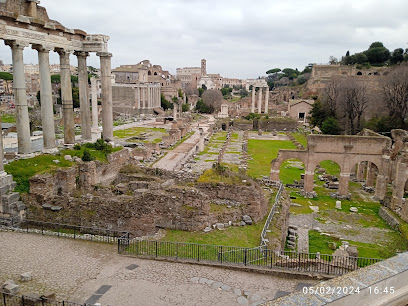
Lupa Capitolina
0.1 km
Discover the Lupa Capitolina, a legendary symbol of Rome's foundation and a captivating historical sculpture in the heart of the Eternal City.

Fountain of the Goddess Roma
0.1 km
Discover the Fountain of the Goddess Roma, a stunning masterpiece in Piazza del Campidoglio, embodying the rich history and beauty of the Eternal City.

Basilica Emilia
0.1 km
Explore the ancient allure of Basilica Emilia in Rome, a historical landmark that reveals the rich tapestry of Roman civilization and architecture.

Complex of the Victorian Ala Brasini
0.1 km
Discover the Complex of the Victorian Ala Brasini, a cultural landmark in Rome showcasing exquisite art, rich history, and architectural beauty.

Forum Iulium
0.1 km
Experience the grandeur of ancient Rome at Forum Iulium, a historical landmark that reveals the city's rich cultural heritage.

Essential places to dine
In Roma - since 1917
0.3 km
Discover authentic Italian flavors at In Roma - where tradition meets culinary excellence in the heart of Rome.

Ristorante Roof Garden
0.3 km
Experience exquisite Italian cuisine with breathtaking views at Ristorante Roof Garden in the heart of Rome.
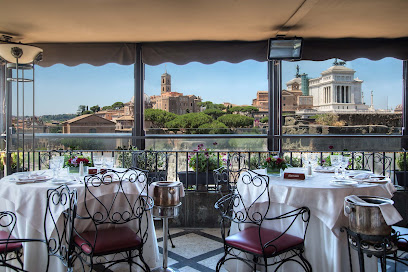
Unique Al Palatino Garden Restaurant
0.3 km
Experience authentic Italian cuisine amidst lush gardens at Unique Al Palatino Garden Restaurant in Rome.

La Taverna dei Fori Imperiali
0.4 km
Experience authentic Italian cuisine at La Taverna dei Fori Imperiali in Rome – where tradition meets flavor in every dish.

Iari The Vino
0.4 km
Experience authentic Italian cuisine at Iari The Vino in Rome - home to exquisite ravioli and warm hospitality.

Ristorante Ad hoc
0.6 km
Experience authentic Italian cuisine at Ristorante Ad hoc in Rome – where every meal is a celebration of flavor and tradition.

Hedera - Osteria Contemporanea
0.6 km
Experience modern Italian cuisine at Hedera - Osteria Contemporanea in Rome; a perfect blend of tradition and innovation awaits you.

Ce Stamo A Pensà
0.6 km
Experience authentic Southern Italian cuisine at Ce Stamo A Pensà in Rome—where every dish tells a story.

Ristorante il Buco Roma
0.7 km
Experience authentic Tuscan flavors at Ristorante il Buco in Rome—where tradition meets taste.

Hostaria da Nerone
0.7 km
Experience the essence of Rome at Hostaria da Nerone with authentic dishes that celebrate Italy's rich culinary heritage.

Sphaeristerium
0.7 km
Experience authentic Italian flavors at Sphaeristerium - where tradition meets culinary excellence in the heart of Rome.

La Ciambella
0.8 km
Discover authentic Italian cuisine at La Ciambella in Rome - where every dish celebrates the rich flavors of Italy.

Da Nina a Trastevere
0.8 km
Discover authentic Sicilian cuisine at Da Nina a Trastevere—where every dish tells a story in the heart of Rome.

Ristorante Il Falchetto
0.8 km
Experience the authentic flavors of Italy at Ristorante Il Falchetto, where traditional Roman dishes meet exceptional seafood delights.

Ristorante Caffè Martini & Rossi
0.9 km
Experience exquisite Italian cuisine at Ristorante Caffè Martini & Rossi with stunning views of the Colosseum in Rome.

Markets, malls and hidden boutiques
Souvenir Roma
0.4 km
Discover exquisite gifts and authentic Italian souvenirs at Souvenir Roma, the ultimate stop for tourists in Rome.

Boutique dei Serpenti - Borse e Bijoux Roma
0.6 km
Explore Boutique dei Serpenti in Rome for exquisite Italian handbags and jewelry, showcasing unique craftsmanship and timeless style.

PODERE VECCIANO
0.6 km
Discover authentic Italian flavors and exquisite wines at Podere Vecciano, the charming supermarket and grocery store in the heart of Rome.

Pifebo Vintage Shop
0.6 km
Explore Pifebo Vintage Shop in Rome for unique vintage clothing and accessories, where every piece tells a story of timeless fashion.

King Size Vintage
0.6 km
Shop unique vintage clothing at King Size Vintage in Rome, where every piece has a story and timeless style awaits.

SUFIR
0.6 km
Discover SUFIR in Rome: your ultimate destination for exquisite leather goods, handcrafted handbags, and stylish dresses.

The Oliver wardrobe
0.7 km
Discover unique vintage and baby clothing at The Oliver Wardrobe, a charming used clothing store in the heart of Rome.

Blue Goose
0.7 km
Explore a vintage clothing haven in Rome's heart, where every piece tells a story and fashion meets history.

Kokoro
0.7 km
Explore Kokoro, a chic women's clothing boutique in Rome, showcasing unique styles and quality fashion for every occasion.

Pulp vintage
0.7 km
Discover timeless fashion treasures at Pulp Vintage, a unique clothing store in the heart of Rome, where each piece tells a story.

Hang Roma - Unconventional Leather Bags Handmade in Rome - Borse e Accessori In cuoio
0.7 km
Discover the charm of Italy through exquisite handmade leather goods at Hang Roma, a premier destination for fashion enthusiasts and souvenir hunters alike.

Souvenir shop (gift)
0.8 km
Explore a delightful souvenir shop in Rome, offering unique gifts and authentic Italian craftsmanship, perfect for capturing your travel memories.

Souvenirs Shop - Best Price Souvenirs in Rome
0.8 km
Discover authentic Italian souvenirs at the Best Price Souvenirs Shop in Rome, where quality meets affordability in every unique find.
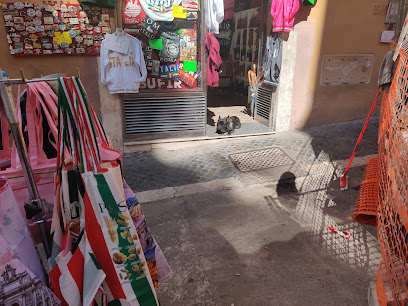
Souvenir fountain
0.8 km
Discover the essence of Rome at Souvenir Fountain, where unique keepsakes and local artistry come together to create unforgettable memories.

BD-SAS
0.8 km
Discover the essence of Rome at BD-SAS, a charming souvenir store offering unique bags and gifts that embody Italian craftsmanship.
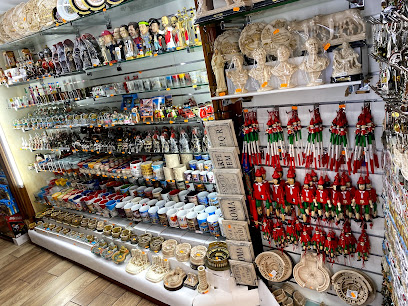
Essential bars & hidden hideouts
Shamrock
0.4 km
Experience the charm of an Irish pub in Rome, where delicious food, refreshing drinks, and a lively atmosphere await you near the Colosseum.

Ice Club Roma
0.4 km
Experience the coolest nightlife at Ice Club Roma, where unique cocktails and vibrant parties await you in the heart of the Eternal City.

Ex Galleria
0.4 km
Discover the perfect fusion of cocktail culture and contemporary art at Ex Galleria, Rome's hidden gem for an unforgettable night out.

Otivm Roof Bar
0.4 km
Discover the enchanting Otivm Roof Bar, where exquisite cocktails meet breathtaking views in the heart of Rome's vibrant nightlife.

Caffè Roma
0.5 km
Experience the charm of Caffè Roma - a cozy coffee shop near the Colosseum, perfect for a delightful break in Rome.

Oppio Caffè
0.7 km
Experience the authentic taste of Italy at Oppio Caffè, a delightful café in Rome offering exquisite dishes, refreshing cocktails, and a vibrant atmosphere.

The Hole Trastevere
0.7 km
Discover the vibrant nightlife of Trastevere at The Hole, a cocktail bar blending creative drinks and local culture in the heart of Rome.

Ri.ONE RoofTop Cocktail bar
0.8 km
Discover the best views and unique cocktails at Ri.ONE RoofTop Cocktail Bar, your perfect escape in the heart of Rome, Italy.

Santa Cocktail Club - Roma
0.8 km
Discover Santa Cocktail Club in Rome, where innovative cocktails and vibrant nightlife create unforgettable memories in the heart of the Eternal City.
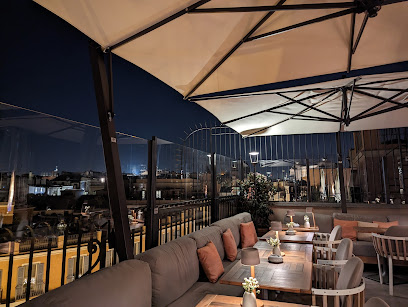
404 Name Not Found
0.8 km
Experience the vibrant cocktail culture at 404 Name Not Found Cocktail Bar, a stylish gem in the heart of Rome, perfect for unwinding and socializing.

Blackmarket Hall
0.9 km
Discover Blackmarket Hall: A vibrant cocktail bar and bistro in Rome offering delicious food, exquisite cocktails, and live music in a lively atmosphere.

Coming Out
0.9 km
Discover the vibrant atmosphere of Coming Out, a renowned gay bar and restaurant in Rome, where inclusivity and nightlife come together.

RoofTop Lounge Trevi
0.9 km
Discover the breathtaking views and exquisite cocktails at RoofTop Lounge Trevi, a premier destination for tourists in Rome.

Goodness Food & Wine Roma
0.9 km
Experience the finest Italian wines and authentic cuisine at Goodness Food & Wine Roma, where every sip and bite tells a story.
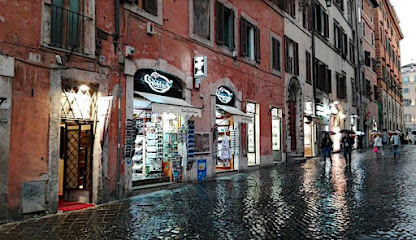
Bar Fontana di Trevi
0.9 km
Discover the delightful Bar Fontana di Trevi, a charming spot for gelato and drinks near Rome's iconic Trevi Fountain.




